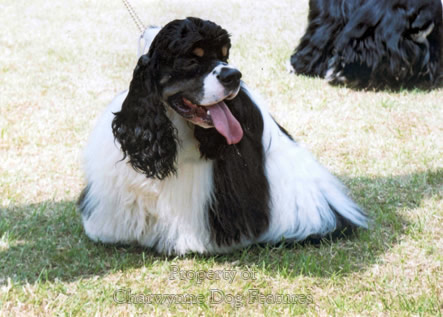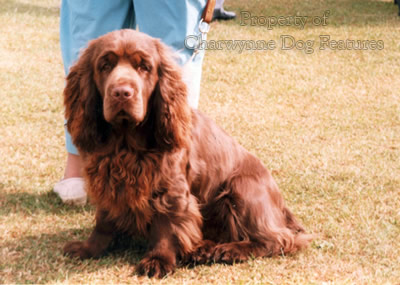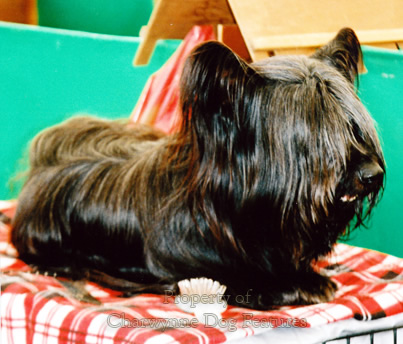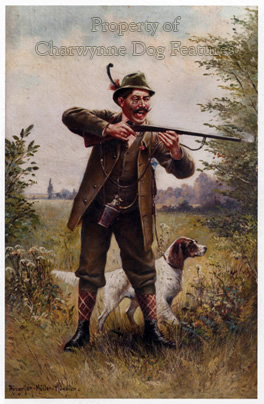318 Fashions in Dogs
DOGS IN AND OUT OF FASHION
by David Hancock
 "...how well in thee appears
"...how well in thee appears
The constant service of the antique world,
When service sweat for duty, not for meed!
Thou art not for the fashion of these times..."
Those words from Shakespeare's 'As You Like It' could well apply to breeds of dog, for the 20th century saw huge swings in the popularity of so many breeds. The latter half of the last century could be summarised by two dominant features: the extraordinary increase in foreign breeds becoming recognised and favoured here and the remarkable popularity of German breeds in the United Kingdom. One sad aspect of these changes however has been the threat to some of our native breeds, some of which could be lost to us in this century and all of them from 'the antique world.'
In 1908 Toy breeds like the Affenpinscher, Australian Silky terrier, Bichon frise, Bolognese, Cavalier King Charles spaniel, Chihuahua, Chinese Crested, Havanese, Lowchen and Miniature Pinscher were not even listed by the KC; twice as many King Charles spaniels and Pomeranians were however registered in 1908 than in 1999. Royal patronage has played a part in these changing fortunes, the Pembroke Welsh corgi not being registered as a breed until 1925, going from 20 then to over 4,000 in 1969. The most popular breed in 1908 was the fox terrier, with 1,800 smooths and 1,400 wire-haired dogs being registered. In 1999, only 170 smooths and 600 wire-haired fox terriers were registered. 
Thirty years ago, breeds like the Afghan Hound, (2,800 registered in 1970, 259 in 1999), the Beagle (3,900 registered in 1969, 991 in 1999) and the Pekingese (4,243 registered in 1970, 988 in 1999) were much more popular. The rise of the German breeds, even in thirty years has been astonishing; 16,000 German shepherd dogs were registered in 1970, 25,690 in 1996 but not one was listed in 1910. 164 Rottweilers were registered in 1970, 10,341 in 1989. 187 Weimaraners were registered in 1969, 2,743 in 1998. 
In 1999, the Kennel Club newly registered well over 1,000 German short-haired pointers against 800 of our own; over 500 American Cocker Spaniels against 89 Sussex Spaniels and more Brittanys than either Field or Clumber Spaniels. Shakespeare may have written that our mastiffs 'are of unmatchable courage' but the public prefer a German mastiff, the Great Dane, with over 2,000 of the latter registered each year, against around 500 of our native breed. In the light of this, you could be forgiven for thinking that we are doing a great deal to perpetuate foreign breeds and very little to conserve our own native breeds. There is a serious threat to a number of our renowned British breeds which could lead in time to their disappearance . .jpg)
Even fifty years ago, the shooting men went for British gundogs; not any more. Each year an additional three and a half thousand pointers from Germany increase the German representation, to outnumber the combined annual registrations of all the setter breeds and the pointer of these islands. More Italian spinones and Hungarian vizslas are registered annually than four of our spaniel breeds. The preference for 'hunt, point and retrieve' breeds has largely caused this, but if our ancestors had needed an allrounder, they would have bred one themselves -- and it would have become world famous. Have our sportsmen lost their breeding skills as well as their patriotism? The Kennel Club may claim that they have never lost a native breed from their lists but that is not due to their patriotic interest but the devotion of committed fanciers.
The success story of the 20th century is undoubtedly that of the Labrador retriever, with the golden retriever and the English springer not far behind. In his 'Dogs since 1900', Arthur Croxton Smith wrote: "The year 1903 was memorable in the history of Labradors, which had hitherto been little known except among a few select sporting families...I must admit that before 1903 I had never seen one...Then in that year a class was provided for them at the Kennel Club show at the Crystal Palace." In 1908, 123 were registered, in 1912 - 281, in 1922 - 916, by the 1950s 4,000 were being registered each year, in the 1980s - 15,000 a year, rising to nearly 36,000 in 1998. No other breed in the history of pure-bred dogs can match that rise in popularity. 
The Kennel Club recognises over 50 breeds in their Working and Pastoral Groups; 42 of them originated overseas. Most of these breeds were not even in Britain at the beginning of the 20th century. Of the 23 breeds in the Toy Group, 19 of them came from abroad. 24 of the 25 breeds in the Utility Group came to us from overseas. 26 of the 33 breeds in the Hound Group came from outside the United Kingdom. Every year more breeds come on to the register, some of them from strange backgrounds. The pretentiously named Pharoah hound is actually a rabbit dog from Gozo; around 300 have been registered in the last ten years. Foreign breeders rarely let their best stock go; without long breeding records, who knows what 'genetic junk' we are introducing?
Against that background it is disturbing to check the registrations of those of our native breeds, with extremely long breeding records, with fewer than 200 being bred each year: the curly-coated retriever; Clumber, field, Irish water and Sussex spaniels; Dandie Dinmont, Manchester, Norwich, Sealyham, Skye, English Toy (black and Tan) and miniature bull terriers; smooth collie, Otterhound, Bloodhound and Welsh corgi (Cardigan). Their names alone usually show how British they are. 
As the Sealyham terrier fades (182 registered in 1989, only 58 in 1999) and the Dandie Dinmont terrier declines (256 in 1988, only 107 in 1999), we are importing the Cesky terrier, developed overseas from the Sealyham. As the field spaniel struggles to gain new owners (122 in 1989, against 75 in 1999), the Hungarian Vizsla goes from 223 in 1990 to over 600 in 1999. We lost our English water spaniel but now import both the Portuguese and the Spanish water dogs. As the smooth collie goes from 148 registrations in 1989 to 82 in 1999, we favour four times that number of Belgian shepherd dogs, 443 being registered in 1999. Eight times as many Siberian huskies were registered here in 1999 than Skye terriers. In such a way did we lose the English white terrier, an elegant charming dog and a long established breed-type.
Glamorous breeds like the sighthound breeds: the Afghan hound, the borzoi and the saluki, and a handsome gundog breed like the Irish setter, often accompany beautifully dressed models on photo shoots nowadays. Earlier in the 20th century Toy dogs or cocker spaniels would have been a more likely choice. The Duke and Duchess of Windsor did much to popularise the pug, as did Queen Victoria, who also had fox terriers. Queen Victoria's heir, Edward VII, had a fox terrier, Caesar, which led his funeral procession. Without royal patronage breeds like the borzoi, favoured by Queen Alexandra, the Pomeranian, favoured by Queen Victoria, and the royal corgis of today may never have achieved the profile they enjoy today. 
Is there a need to restrict the entirely capricious and wholly unjustified fashion for importing fresh foreign breeds into this country? Coming along behind the German short-haired pointers are the Stichelhaars and the Langhaars, behind the Large Munsterlander is the small variety and then there are the French pointers: the Braque D'Auvergne, the Braque St.Germain and the two sizes of Braque Francais, and the Epagneuls: Picard, de Pont-Audemer and Francais, as well as the Dutch dogs: the Stabyhoun and the Drentse Patrijshond--we could be overwhelmed!
The Federation Cynologique Internationale (FCI) or world kennel club, recognises 340 breeds, well over twice the number recognised by our KC and the American KC. But the FCI has at last acknowledged the need to restrict the number of new breeds it accepts. It now demands a minimum of eight distinct bloodlines, at least a thousand dogs registered and evidence of control of hereditary problems. Against those criteria, breeds like the Chinese Shar Pei would never be allowed in here. There is now a real need for more awareness of old British breeds. It would be good to see the admirable curly-coated retriever becoming more popular as a companion dog. The huge popularity of the Labrador has resulted in both over-breeding and unwise breeding leading to undesirable health problems in some stock, as it has in the golden retriever too.
But fashion is fickle and breeds can suffer cruelly from it. A few years ago my vet told me of an aged but perfectly sound golden retriever being brought in to his surgery for destruction because his owner wanted one of those Beardies she'd seen in television advertisements, publicising a product she couldn't recall. Watch out Beardies, your time will come too!